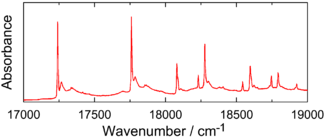
Shpolskii matrix
Encyclopedia

Chromophore
A chromophore is the part of a molecule responsible for its color. The color arises when a molecule absorbs certain wavelengths of visible light and transmits or reflects others. The chromophore is a region in the molecule where the energy difference between two different molecular orbitals falls...
embedded in a crystalline matrix. The fluorescence
Fluorescence
Fluorescence is the emission of light by a substance that has absorbed light or other electromagnetic radiation of a different wavelength. It is a form of luminescence. In most cases, emitted light has a longer wavelength, and therefore lower energy, than the absorbed radiation...
emission spectra and absorption spectra of Shpolskii matrices exhibit narrow lines instead of the inhomogeneously broadened features normally associated with spectra of chromophores in liquids or solids. The phenomena was first described by Eduard Shpolsky
Eduard Shpolsky
Eduard Vladimirovich Shpolsky, also Shpolsk'ii, Shpolskii was a Russian and Soviet physicist and educator, co-founder and lifelong editor of Uspekhi Fizicheskikh Nauk journal .Shpolsky primary scientific contribution belongs to the field of molecular spectroscopy, particularly luminescence and...
in the 1950s and 1960's in the journals Transactions of the U.S.S.R. Academy of Sciences and Soviet Physics Uspekhi.
Shpolskii matrices are formed when each chromophore neatly replaces one or more molecules in the host crystalline lattice
Crystal structure
In mineralogy and crystallography, crystal structure is a unique arrangement of atoms or molecules in a crystalline liquid or solid. A crystal structure is composed of a pattern, a set of atoms arranged in a particular way, and a lattice exhibiting long-range order and symmetry...
. A good match between the chromophore and the host lattice leads to a uniform environment for all the chromophores and hence greatly reduces the inhomogeneous broadening of the electronic transitions. In addition to the weak inhomogeneous broadening of the transitions, the quasi-lines observed at very low tempeatures are phonon
Phonon
In physics, a phonon is a collective excitation in a periodic, elastic arrangement of atoms or molecules in condensed matter, such as solids and some liquids...
-less transitions. Since phonons originate in the lattice, an additional requirement is weak chromophore-lattice coupling. Weak coupling increases the probability of phonon-less transitions and hence favors the narrow zero phonon lines
Zero-phonon line and phonon sideband
The zero-phonon line and the phonon sideband jointly constitute the line shape of individual light absorbing and emitting molecules embedded into a transparent solid matrix. When the host matrix contains many chromophores, each will contribute a zero-phonon line and a phonon sideband to the...
. The weak coupling is usually expressed in terms of the Debye-Waller factor
Debye-Waller factor
The Debye–Waller factor , named after Peter Debye and Ivar Waller, is used in condensed matter physics to describe the attenuation of x-ray scattering or coherent neutron scattering caused by thermal motion. It has also been called the B factor or the temperature factor...
, where a maximum value of one indicates no coupling between the chromophore and the lattice phonons. The narrow lines characteristic of the Shpolskii matrix are only observed at cryogenic temperatures because at higher temperatures many phonons are active in the lattice and all of the amplitude of the transition shifts to the broad phonon sideband
Zero-phonon line and phonon sideband
The zero-phonon line and the phonon sideband jointly constitute the line shape of individual light absorbing and emitting molecules embedded into a transparent solid matrix. When the host matrix contains many chromophores, each will contribute a zero-phonon line and a phonon sideband to the...
. The original observation was made at liquid nitrogen
Liquid nitrogen
Liquid nitrogen is nitrogen in a liquid state at a very low temperature. It is produced industrially by fractional distillation of liquid air. Liquid nitrogen is a colourless clear liquid with density of 0.807 g/mL at its boiling point and a dielectric constant of 1.4...
temperature (77 kelvins), but using temperatures close to that of liquid helium
Helium
Helium is the chemical element with atomic number 2 and an atomic weight of 4.002602, which is represented by the symbol He. It is a colorless, odorless, tasteless, non-toxic, inert, monatomic gas that heads the noble gas group in the periodic table...
(4.2 K) yields much sharper spectral lines and is the usual practice.
Shpolskii matrices result from fortuitous compatibility between the chromophore and the host matrix and most of the known systems consist of dilute solutions of mono- or polycyclic aromatic hydrocarbon
Polycyclic aromatic hydrocarbon
Polycyclic aromatic hydrocarbons , also known as poly-aromatic hydrocarbons or polynuclear aromatic hydrocarbons, are potent atmospheric pollutants that consist of fused aromatic rings and do not contain heteroatoms or carry substituents. Naphthalene is the simplest example of a PAH...
s in low molecular weight linear alkanes. The solution is often flash frozen with cold helium gas. Linear alkanes interact weakly with the chromophores and crystallize when frozen. The length of the alkanes is often chosen to approximately match the dimensions of the chromophore, and are usually in the size range between n-pentane and n-dodecane.

